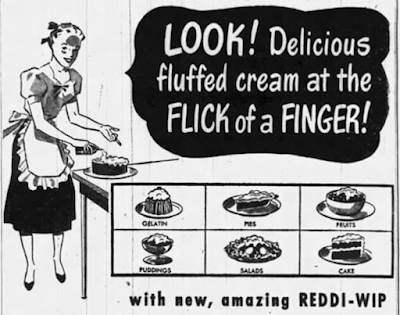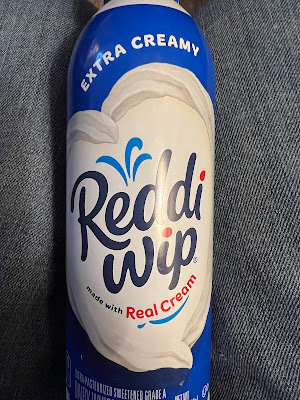It tops so many different desserts and dishes, from a mound atop an ice cream sundae to a dollop atop a Belgian waffle. You'll find it atop hot chocolate and frappes, creme brûlée and bread pudding, and so much more. I'm certainly a huge fan of whipped cream, especially home-made, though I won't turn down almost any type.
Today, let us celebrate National Whipped Cream Day, giving even more love to this tasty treat! I haven't been able to pin down the exact origins of this holiday, but its first known reference extends back at least to the end of 1983, forty years ago. The earliest reference I found (mentioned in a late 1983 newspaper) was to a calendar, The 1984 Calendar of Self Indulgence, by Sandra Boynton. The calendar listed numerous food holidays, including National Whipped Cream Day, which was celebrated on January 5.
Today, let us celebrate National Whipped Cream Day, giving even more love to this tasty treat! I haven't been able to pin down the exact origins of this holiday, but its first known reference extends back at least to the end of 1983, forty years ago. The earliest reference I found (mentioned in a late 1983 newspaper) was to a calendar, The 1984 Calendar of Self Indulgence, by Sandra Boynton. The calendar listed numerous food holidays, including National Whipped Cream Day, which was celebrated on January 5.
Did Sandra actually invent this holiday, and maybe other food holidays, just to fill up her calendar with interesting items? It's possible, although I haven't found anything yet to confirm it. In addition, it's likely that this holiday is connected in some respect to Aaron Lapin, the creator of Reddi-Wip, the first canned whipped cream. It seems more than coincidental that National Whipped Cream Day occurs on Aaron's birthday.
Whipped cream has existed at least as far back as the 16th century, although it wasn't called "whipped cream" until the late 17th century. Although the Oxford English Dictionary claims the first use of the term "whipped cream" was in 1673, I found an earlier reference. In The Closet of the Eminently Learned Sir Kenelme Digbie Kt. Opened, an English cookbook from 1669, there was a recipe for Crème Fouettée, the French term for "whipped cream." However, within the recipe, it was also referred to as "whipped cream." The passage stated, "If you would have your whipped cream light and frothy, ..."
It's also interesting to note that the recipe called for the sweet thick cream to be whipped with "...white hard rushes (of such as they make whisks to brush coats) tied together,.." This use of branches and such was apparently common for at least a couple centuries. The metal whisk wouldn't be invented until around 1840.
The 20th century would see the significant influence of technology on this sweet whipped topping, and Aaron Lapin spearheaded those changes.
Who was Aaron Lapin?
The St. Louis Post-Dispatch (MO), January 5, 1951, provided an abundance of information about Lapin, with The Los Angeles Times (CA), July 13, 1999, adding some additional details. Aaron Soffer Lapin was born on January 5, 1914, and as January 5 is National Whipped Cream Day, it's very likely the date was chosen by the inventor of this holiday to honor Lapin's birthday, especially considering his significant contribution to the whipped cream industry.
Making your own whipped cream isn't difficult but using a can of Reddi-Wip is so much easier, and there's no mixing bowl to later clean. In addition, who hasn't sprayed a can of whipped cream directly into their mouth? I have done so on multiple occasions, and probably will do it again in the future. Interestingly, Cool Whip is currently the most popular whipped dessert topping, and Reddi-Wip is now in second place. However, I'd much rather have Reddi-Wip than Cool Whip.
What's your favorite dessert topped with whipped cream?
Who was Aaron Lapin?
The St. Louis Post-Dispatch (MO), January 5, 1951, provided an abundance of information about Lapin, with The Los Angeles Times (CA), July 13, 1999, adding some additional details. Aaron Soffer Lapin was born on January 5, 1914, and as January 5 is National Whipped Cream Day, it's very likely the date was chosen by the inventor of this holiday to honor Lapin's birthday, especially considering his significant contribution to the whipped cream industry.
Lapin graduated from the University of Missouri, Columbia, and then attended the Washington University Law School. It was during this time that he acquired the nickname "Bunny" as his friends realized that his surname, Lapin, meant "rabbit" in French. However, in 1935, Lapin decided not to take the bar exam, and become a lawyer, but instead chose to work in his father’s clothing business. Certainly a major change in careers, and he probably couldn't have predicted the major changes that would come to his career.
As a brief note, the Chula Vista Star (CA), June 24, 1932, reported on a new local product, Sta-Whip, a "healthful vegetable gelatin mixture." It was being marketed by C.C. Inskeep, a scientist and prominent Chula Vista business man. “The new product is decidedly unique in that it may be used with evaporated milk as well as cream and its use as an agent for whipping cream that ‘stays whipped’ is said to be unsurpassed.” In addition, the article noted, “It has the advantage of having a sweet taste only, so there is no conflict with the most delicate flavors of the food in which it is used.” It was apparently a product that made whipped cream last longer.
In 1941, after six years in the clothing business, Lapin traveled to Chicago, to see Mark Lipsky, his brother-in-law, who worked in the milk business. While there, he met Thom Saehlin, a salesman who selling Sta-Whip. They talked for a time, with Lapin quite intrigued about the product. Finally, Lapin decided to buy Saehlin out, taking everything, including the formula for Sta-Whip.
Unfortunately, during World War II, whipped cream was rarely made as it usually required a minimum of 30% butterfat. War time restrictions prevented the production of cream over 19% butterfat, making it far more difficult, if not impossible, to make whipped cream. Sta-Whip though could be used instead of the butterfat, and was also much cheaper. Lapin concluded a deal with the Valley Farm Dairy to make the Sta-Whip, and then Lapin would sell it, with them splitting the profits.
The Sta-Whip started selling well, and he even sold a franchise to make Sta-Whip. There were some negative issues though. Some legal restrictions arose and there were problems with the heat during the summer. Lapin tried to overcome these problems, and one of his experiments was to use a drug store gun to spray out the Sta-Whip. This idea obsessed Lapin, who decided to go the next step, to design a throwaway spray gun.
In December 1947, he started approached the largest can manufacturers with the idea of creating canned, whipped cream, but they told him it was impossible. However, he eventually convinced Knapp-Monarch Co, St. Louis, an appliance manufacturer, to produce the item. “In due time, a special valve came forth which traps the gas that whips the cream inside the can and forces it our as you want it.” What was in the can? “The can you buy contains only cream of 30% butterfat content, the Redd-Wip stabilizer, some vanilla and so-called whipping cream gas.”
The St. Louis Globe-Democrat (MO), July 6, 1948, reported on the new product, canned whipped cream from Reddi-Wip, Inc., which would soon be available from licensed dairies. The whipped cream would last for two weeks, if refrigerated, making it convenient to use at any time.
This might be the first newspaper advertisement for the new Reddi-Wip. The St. Louis Globe-Democrat (MO), July 22, 1948, printed an ad for Reddi-Wip, which noted it sold for 43 cents a can. Contrary to the prior article, the ad stated it stayed good only for one week, not two, in the refrigerator, and other articles around this time would repeat that it only lasted one week.
There was a legal notice in The State (SC), November 30, 1948, where Aaron Lapin, on behalf of Redd-Wip, Inc, which was headquartered in St. Louis, Missouri, applied for a trademark.
Thus, in 1948, Lapin formed a corporation, Reddi-Wip, Inc., with Mark Lipsky, each owning 50% of the stock, although they took on a third partner too, Lou Lang who contributed $15,000 to the company. Lapin filed for a patent (pictured above) for his new dispensing container for "fluffed cream." And for a number of years, their whipped product would more often be referred to as "fluffed cream" rather than "whipped cream."
This might be the first newspaper advertisement for the new Reddi-Wip. The St. Louis Globe-Democrat (MO), July 22, 1948, printed an ad for Reddi-Wip, which noted it sold for 43 cents a can. Contrary to the prior article, the ad stated it stayed good only for one week, not two, in the refrigerator, and other articles around this time would repeat that it only lasted one week.
There was a legal notice in The State (SC), November 30, 1948, where Aaron Lapin, on behalf of Redd-Wip, Inc, which was headquartered in St. Louis, Missouri, applied for a trademark.
In Life Magazine, September 26, 1949, there was an ad for Reddi-Wip. The ad stated the cans were 7 ounces, and could provide almost a quart of whipped cream, which they considered to be "about 31 generous servings." The ad also stated Reddi-Wip was a "boon to busy housewives" and that "Men love the extra glamor that Reddi-Wip gives to plain desserts." There was also a warning that consumers should only get genuine Reddi-Wip, and not any of the imitators.
In the course of three years, the Reddi-Wip business boomed and they had an annual income of $7 Million, producing about 40 million cans each year. They also had 52 licensed plants in the U.S. and Canada producing Redd-Wip with their formula, as well as employing about 750 people across the country.
Lapin claimed that whipped cream consumption had doubled since Reddi-Wip first came on the market. The St. Louis Post-Dispatch also stated “Even embittered competitors cannot deny that in three short years this upstart from St. Louis has become the king of sweet white fluff.” Canned whipped cream was a game-changer so it's only appropriate that National Whipped Cream Day takes place on Lapin's birthday.
Making your own whipped cream isn't difficult but using a can of Reddi-Wip is so much easier, and there's no mixing bowl to later clean. In addition, who hasn't sprayed a can of whipped cream directly into their mouth? I have done so on multiple occasions, and probably will do it again in the future. Interestingly, Cool Whip is currently the most popular whipped dessert topping, and Reddi-Wip is now in second place. However, I'd much rather have Reddi-Wip than Cool Whip.
What's your favorite dessert topped with whipped cream?
(Updated/revised from a prior post.)









No comments:
Post a Comment